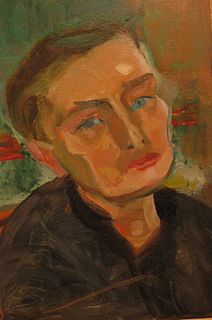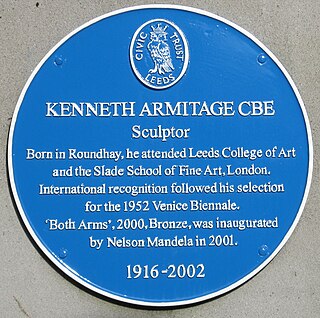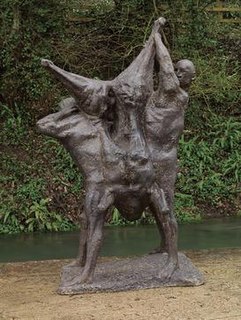
Dame Jocelyn Barbara Hepworth was an English artist and sculptor. Her work exemplifies Modernism and in particular modern sculpture. Along with artists such as Ben Nicholson and Naum Gabo, Hepworth was a leading figure in the colony of artists who resided in St Ives during the Second World War.

Stephen Gilbert was a painter and sculptor from Scotland. He was one of the few British artists fully to embrace the avant-garde movement in Paris in the 1950s.

Sir Anthony Alfred Caro was an English abstract sculptor whose work is characterised by assemblages of metal using 'found' industrial objects. His style was of the modernist school, having worked with Henry Moore early in his career. He was lauded as the greatest British sculptor of his generation.
Bernard Cohen is a British painter. He is regarded as one of the leading British abstract artists of his time.
John Aubrey Clarendon Latham, was a Northern Rhodesian-born British conceptual artist.

Roger Hilton CBE (1911–1975) was a pioneer of abstract art in post-Second World War Britain. Often associated with the 'middle generation' of St Ives painters – Terry Frost, Patrick Heron, Peter Lanyon & Bryan Wynter – he spent much of his career in London, where his work was deeply influenced by European avante-garde movements such as tachisme and CoBrA.

Henry Spencer Moore was an English artist. He is best known for his semi-abstract monumental bronze sculptures which are located around the world as public works of art. As well as sculpture, Moore produced many drawings, including a series depicting Londoners sheltering from the Blitz during the Second World War, along with other graphic works on paper.
Ivon Hitchens was an English painter who started exhibiting during the 1920s. He became part of the 'London Group' of artists and exhibited with them during the 1930s. His house was bombed in 1940 during World War II, at which point he moved to a caravan on a patch of woodland near Petworth in West Sussex. He worked there for the next forty years, gradually augmenting his caravan with a series of buildings. He is particularly well known for panoramic landscape paintings created from blocks of colour. There is a huge mural by him in the main hall of Cecil Sharp House. His work was exhibited in the British Pavilion at the Venice Biennale in 1956.
Lynn Russell Chadwick, was an English sculptor and artist. Much of his work is semi-abstract sculpture in bronze or steel. His work is in the collections of MoMA in New York, the Tate in London and the Centre Georges Pompidou in Paris.
(David) Gwyther (Broome) Irwin was a British abstract artist born in Basingstoke, Hampshire, who had lived much of his life in north Cornwall. He was educated in Dorset, at Goldsmiths College and at the Central School of Art in London 1951–1954. Irwin first came to prominence in 1957 with an exhibition at Gallery One, and another at Gimpel Fils in 1959. In 1964, he represented Britain at the Venice Biennale, along with Joe Tilson, Bernard Meadows and Roger Hilton. In 1960, he married Elizabeth Gowlett and they had two sons and one daughter.

William Kenneth Armitage was a British sculptor known for his semi-abstract bronzes.

William Turnbull was a Scottish artist.

Andrew Sabin is a British sculptor. He studied at Chelsea College of Art (1979–1983) where he worked as a senior lecturer until 2006.
Anthony Benjamin FRSA, RE was an English painter, sculptor and printmaker. Referred to as a 'polymathic artist' by critic Rosemary Simmons when writing about his work for the Borderline Images By Anthony Benjamin show at The Graffiti Gallery in 1979.
Robert Adams was an English sculptor and designer. Whilst not widely known outside of artistic circles, he was nonetheless regarded as one of the foremost sculptors of his generation. In a critical review of a retrospective mounted by the Gimpel Fils gallery in London in 1993, Brian Glasser of Time Out magazine described Adams as "the neglected genius of post-war British sculpture", a sentiment echoed by Tim Hilton in the Sunday Independent, who ranked Adams' work above that of his contemporaries, Ken Armitage, Reg Butler, Lynn Chadwick and Bernard Meadows.

Sea Form (Atlantic) is a 1964 bronze sculpture by English artist Barbara Hepworth. It measures 204 cm × 107 cm × 73 cm.

Ralph Brown was an English sculptor who came to national prominence in the late 1950s with his large-scale bronze Meat Porters, commissioned for Harlow New Town, Essex and is known for his sensual, figurative sculptures.
The Geometry of Fear was an informal group or school of young British sculptors in the years after the Second World War. The term was coined by Herbert Read in 1952 in his description of the work of the eight British artists represented in the "New Aspects of British Sculpture" exhibition at the Biennale di Venezia of 1952.
Leslie Tillotson Thornton was an English sculptor.

The British pavilion houses Great Britain's national representation during the Venice Biennale arts festivals.












